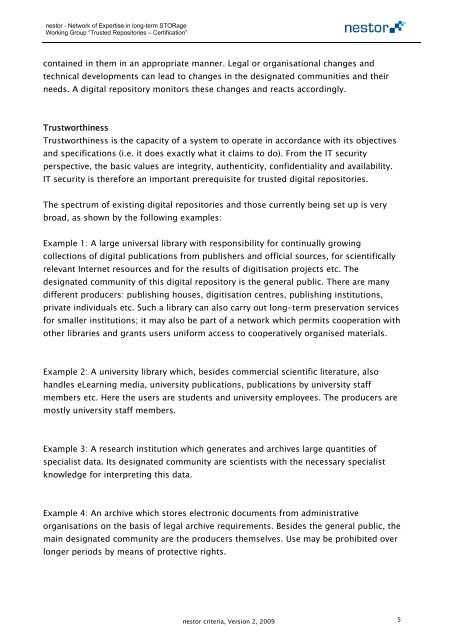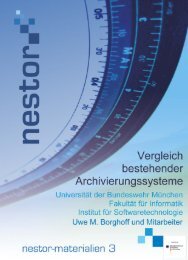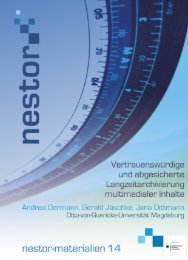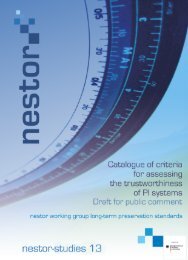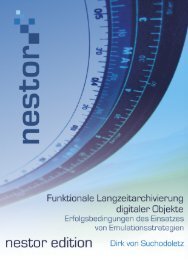nestor criteria : Catalogue of Criteria for Trusted Digital Repositories
nestor criteria : Catalogue of Criteria for Trusted Digital Repositories
nestor criteria : Catalogue of Criteria for Trusted Digital Repositories
You also want an ePaper? Increase the reach of your titles
YUMPU automatically turns print PDFs into web optimized ePapers that Google loves.
<strong>nestor</strong> - Network <strong>of</strong> Expertise in long-term STORage<br />
Working Group “<strong>Trusted</strong> <strong>Repositories</strong> – Certification”<br />
contained in them in an appropriate manner. Legal or organisational changes and<br />
technical developments can lead to changes in the designated communities and their<br />
needs. A digital repository monitors these changes and reacts accordingly.<br />
Trustworthiness<br />
Trustworthiness is the capacity <strong>of</strong> a system to operate in accordance with its objectives<br />
and specifications (i.e. it does exactly what it claims to do). From the IT security<br />
perspective, the basic values are integrity, authenticity, confidentiality and availability.<br />
IT security is there<strong>for</strong>e an important prerequisite <strong>for</strong> trusted digital repositories.<br />
The spectrum <strong>of</strong> existing digital repositories and those currently being set up is very<br />
broad, as shown by the following examples:<br />
Example 1: A large universal library with responsibility <strong>for</strong> continually growing<br />
collections <strong>of</strong> digital publications from publishers and <strong>of</strong>ficial sources, <strong>for</strong> scientifically<br />
relevant Internet resources and <strong>for</strong> the results <strong>of</strong> digitisation projects etc. The<br />
designated community <strong>of</strong> this digital repository is the general public. There are many<br />
different producers: publishing houses, digitisation centres, publishing institutions,<br />
private individuals etc. Such a library can also carry out long-term preservation services<br />
<strong>for</strong> smaller institutions; it may also be part <strong>of</strong> a network which permits cooperation with<br />
other libraries and grants users uni<strong>for</strong>m access to cooperatively organised materials.<br />
Example 2: A university library which, besides commercial scientific literature, also<br />
handles eLearning media, university publications, publications by university staff<br />
members etc. Here the users are students and university employees. The producers are<br />
mostly university staff members.<br />
Example 3: A research institution which generates and archives large quantities <strong>of</strong><br />
specialist data. Its designated community are scientists with the necessary specialist<br />
knowledge <strong>for</strong> interpreting this data.<br />
Example 4: An archive which stores electronic documents from administrative<br />
organisations on the basis <strong>of</strong> legal archive requirements. Besides the general public, the<br />
main designated community are the producers themselves. Use may be prohibited over<br />
longer periods by means <strong>of</strong> protective rights.<br />
<strong>nestor</strong> <strong>criteria</strong>, Version 2, 2009 5


